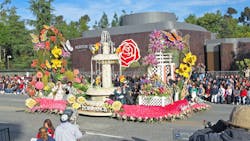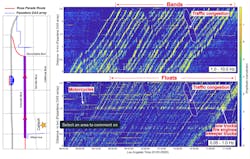Earthquake Sensor Tracks Passing Floats and Bands in the Rose Bowl Parade
Engineers at Caltech helped develop and deploy a citywide optic array late last year for mapping tremors and earthquakes with millimeter resolution as they roll under the Pasadena. Those engineers discovered how sensitive the array was a few weeks later when the Rose Bowl Parade marched through town. The engineer could watch as the array tracked the parade’s floats and bands in detail as they moved down the streets.
The Pasadena Array employs two currently unused, or “dark,” strands of the city’s fiber optic cable network. It is buried just below ground and stretches in a loop around the city. Two laser emitters shoot beams of light through the cables which have tiny defects every few meters; these reflect a small fraction of the laser beam back to the source. The reflections are tracked and recorded, so each defect becomes a trackable location.
Seismic waves travelling underground make the fiber-optic cable expand and contract slightly, which changes the travel time of light to and from these waypoints. So, by tracking the motion of the defects, it also tracks the motion of earthquakes. The technique is known as Distributed Acoustic Sensing, or DAS.
The Pasadena Array has more than 5,000 of these defects and about 400 are positioned along the parade route. Researchers found that floats weighing between 35,000 and 40,000 lb created distinct long-period signals; marching bands produced weaker long-period signals, but strong signals in the 1.0 to 10 Hz frequencies.
Digging into the data, the researchers could identify the most ground-shaking bands (Southern University, A&M College and the hometown Pasadena City College Honor Band). They could also spot the gap caused when the float “Mrs. Meyer’s Clean Day” got stuck at the corner of Colorado and Sierra Madre boulevards for six minutes.

